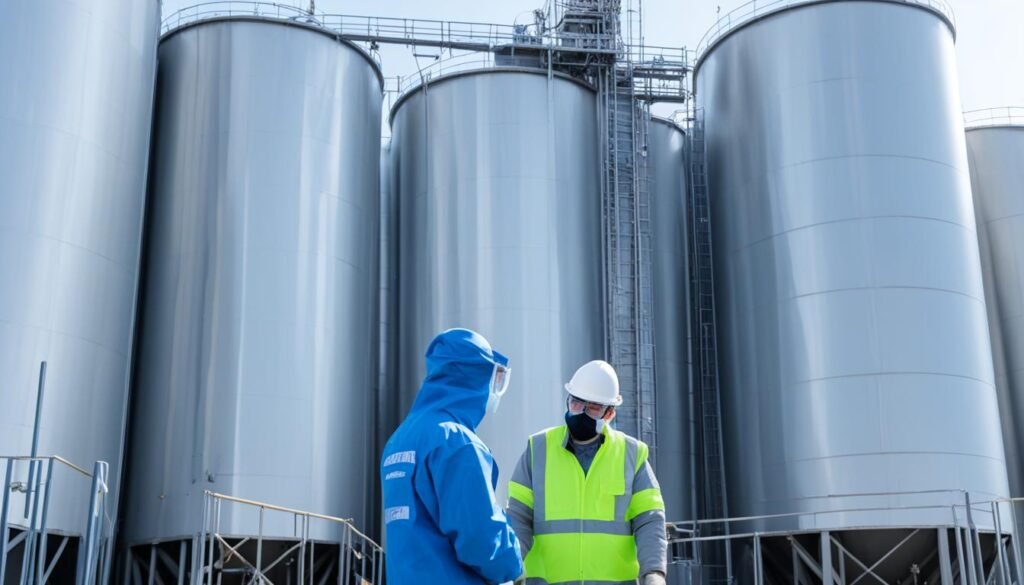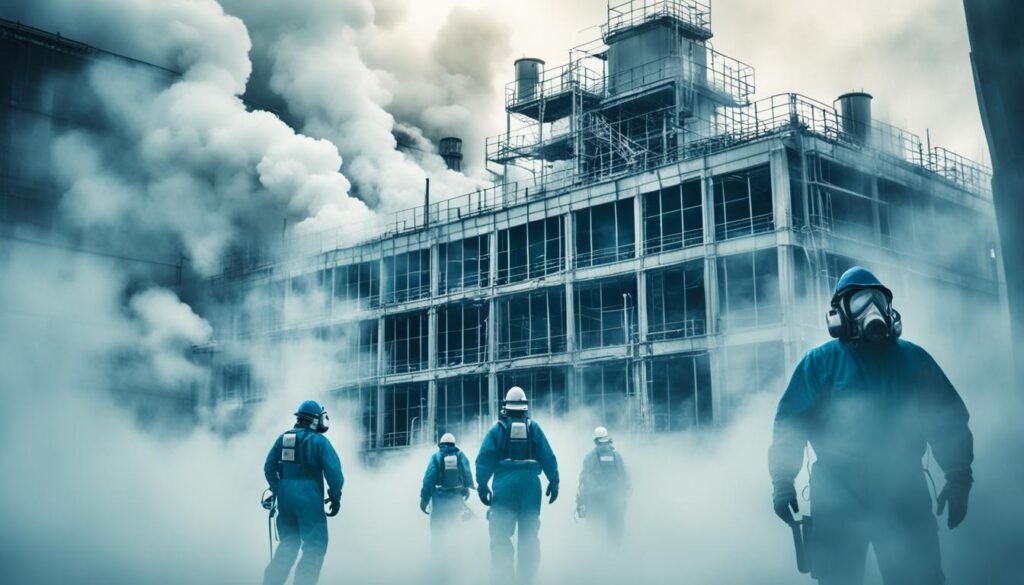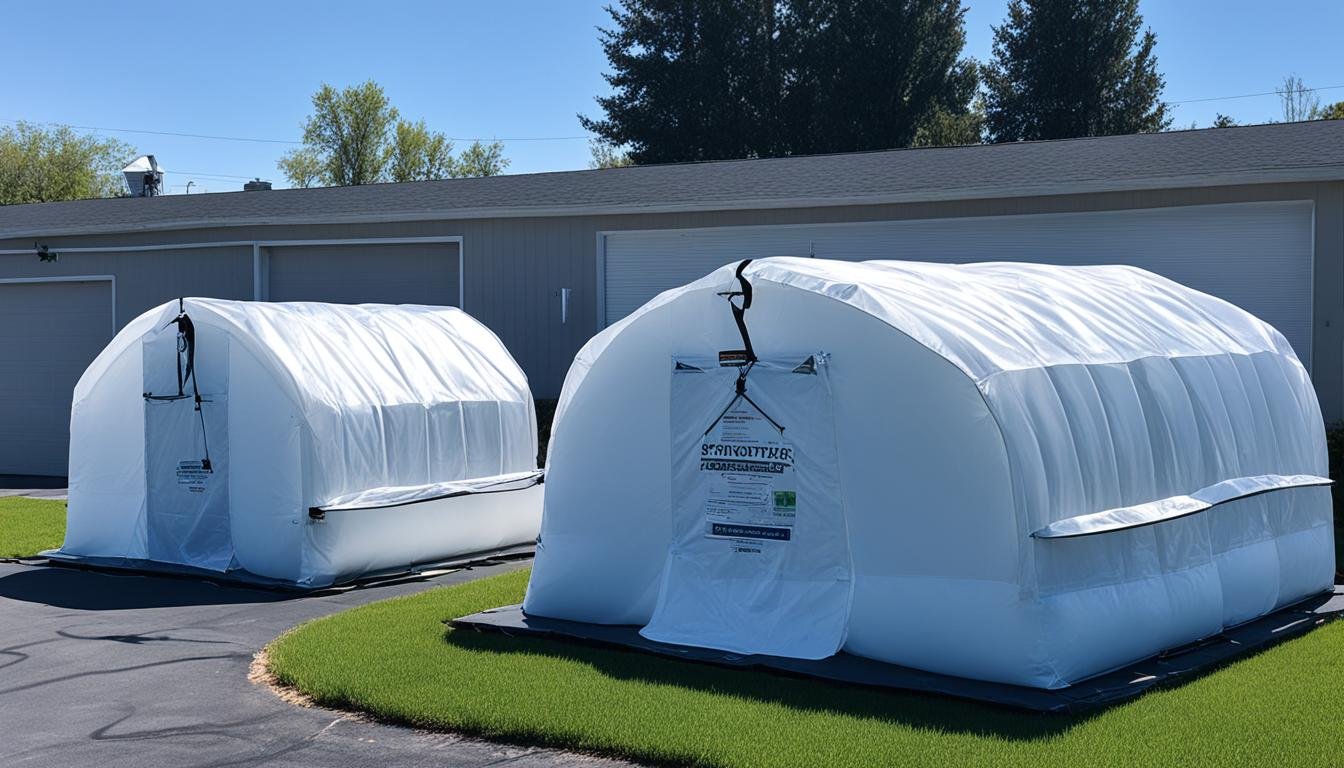Did you know that fumigation is a widely used method for eliminating pests in structures? From residential homes to commercial buildings, fumigation services play a crucial role in maintaining a pest-free environment.
Structural fumigation involves filling the airspace within a structure with a toxic gas, effectively targeting pests like drywood termites and bed bugs. The process utilizes a tarp to seal the structure, allowing the gas to penetrate cracks, crevices, and wood pores, ensuring complete elimination of pests.
Key Takeaways:
- Fumigation is a widely used method for pest control in various structures.
- It is effective in eliminating pests such as drywood termites and bed bugs.
- The process involves sealing the structure with a tarp and filling it with a toxic gas.
- Fumigation is commonly used for residential and commercial buildings.
- Certified applicators carry out fumigation and follow strict safety procedures.
Fumigation Process and Safety Measures
The fumigation process involves several steps to ensure both safety and effectiveness. Whether it’s residential or commercial fumigation, following proper methods and safety measures is crucial to protect both occupants and the environment.
1. Preparation
Before the fumigation begins, thorough preparation is necessary. Remove all people, pets, plants, and items that are not sealed in airtight containers from the structure. Turn off pilot lights and electrical heating elements, and open all doors and drawers. This preparation will facilitate the fumigation process and prevent any potential hazards.
2. Sealing and Warning Agent
During the fumigation, the structure is carefully sealed with a tarp to create an airtight enclosure. This containment method ensures that the fumigant gas remains trapped inside, effectively reaching all areas of the structure, including cracks, crevices, and wood pores where pests may be hiding. To clear the area during fumigation, a warning agent, such as chloropicrin, may be released. Its strong smell alerts anyone nearby to stay away.
3. Air Monitoring
Continuous air monitoring is conducted throughout the fumigation process to ensure that the levels of sulfuryl fluoride, the primary active ingredient in fumigants, do not exceed the established safety limits. This monitoring ensures the safety of both the occupants and the environment by preventing overexposure to the fumigant gas.
4. Aeration and Reentry
After the fumigation is complete, the structure is aerated to remove any remaining fumigant gas. This process involves allowing fresh air to circulate within the structure until the gas levels return to safe levels. Once the applicator deems it safe, occupants can reenter the structure without any health risks.
Safety Precautions
To ensure a safe fumigation experience, it is important to follow specific safety precautions:
- Inform neighbors about the upcoming fumigation to ensure their safety as well.
- Remove all food and medications from the structure to prevent contamination.
- Turn off pilot lights and open flames as a precautionary measure.
By following these safety measures and cooperating with certified applicators, you can ensure a successful and safe fumigation process.
| Fumigation Methods | Fumigation Safety Measures | Residential Fumigation | Commercial Fumigation |
|---|---|---|---|
| Structural Fumigation | Thorough Preparation | Safe Evacuation of Occupants | Protection of Valuable Assets |
| Tent Fumigation | Proper Sealing and Warning Agents | Protection of Personal Belongings | Minimal Disruption to Business Operations |
| Localized Fumigation | Air Monitoring for Optimal Safety | Compliance with Residential Regulations | Compliance with Commercial Standards |

Preparing Your Home or Business for Fumigation
Prior to beginning the fumigation process, it is crucial to properly prepare your home or business to ensure the effectiveness of the treatment. By following these essential steps, you can enhance the efficiency of building fumigation and optimize pest control for structures.
Gather and Remove Vulnerable Items
Before the fumigation, you should identify and remove any items that may be vulnerable to the fumigant. This includes food, feed, and medications, which should be double-bagged or sealed in airtight containers to prevent contamination. By taking these precautions, you can protect your belongings and maintain their quality.
Open Doors and Drawers
In order to allow the fumigant to penetrate all areas of the structure, it is important to open doors and drawers throughout your home or business. This will ensure comprehensive coverage and improved effectiveness in eliminating pests.
Unplug Electrical Devices
For safety reasons, it is recommended to unplug all electrical devices within the structure prior to fumigation. This includes appliances, lamps, and other electronic equipment. By doing so, you can prevent any potential damage that may occur as a result of exposure to the fumigant.
Inform Neighbors
As a courtesy and for the safety of others in the vicinity, it is advisable to inform your neighbors about the upcoming fumigation. This enables them to take necessary precautions, such as keeping windows closed, to prevent the fumigant from entering their own properties.
Prepare Mattresses and Outdoor Areas
When preparing for building fumigation, it is important to remove waterproof covers from mattresses and pillows. Additionally, plastic coverings on mattresses should be taken off. This allows the fumigant to effectively penetrate and eliminate any pests that may be present.
In outdoor areas, ensure that loose items such as furniture or toys are removed. Cut back plants and tree limbs that may obstruct the fumigation process, ensuring a clear path for the fumigant to reach all areas of your property.
By following these guidelines and adhering to the instructions provided by the fumigation company, you can prepare your home or business adequately for the professional fumigation process. Taking these necessary steps will maximize the effectiveness of the treatment, ensuring optimal pest control for structures.

Conclusion
Fumigation is a highly effective method for controlling pests in structures, whether it’s your home or business. When it comes to professional fumigation services in Orange County, there’s no one better than Your Way Fumigation. Owned by Manuel, they are the go-to pest control company for all your fumigation needs.
If you’re looking for reliable and safe fumigation, Your Way Fumigation is the name you can trust. Their website, bestfumigationanaheim.com, provides comprehensive information about their services and contact details. Hiring a reputable pest control company like Your Way Fumigation ensures that the fumigation process is carried out with the highest level of expertise and safety.
To ensure the success of the fumigation process, it is crucial to follow the proper safety measures and adequately prepare the structure. By taking these steps, you can maximize the effectiveness of the fumigation and eliminate those pesky pests for good.


